This season has been one to forget for RFC Seraing in the Belgian Pro League. In the 2020/21 season, the club from the city of Liège were promoted to the top flight via the promotion/relegation playoff, the first time the club has made it to the top division in their current form. Now, two seasons later, they are heading back down, after a dreadful campaign where they have only won five times all season.
After a relatively poor start to the season, José Jeunechamps was sacked in October after only being appointed in July, something that came as a surprise to many. His replacement, Jean-Sébastien Legros, has not fared any better, with the Belgian only managing 2 wins in his 17 matches in charge.
This tactical analysis and scout report will take a look at some of the struggles that Seraing have had this season, identify what the club could do to improve next season and analyse whether Jeunechamps was potentially sacked too soon.
Lack of chance creation and ball progression leads to a lack of chances
When trying to find the root cause of Seraing’s troubles this season in the Belgian top flight, it is hard to look past their lack of chance creation. In fact, the Liège based side rank dead last in essentially all the key attacking metrics among the Belgian Pro League sides this season. Some of the attacking metrics they rank last in are: goals scored (26), total shots (228, with 6.82 per 90 minutes and a 31.1% shot accuracy), touches in the penalty area (307, 9.18 per 90 minutes), and key passes (48, 1.44 per 90 minutes).
While it will be hard to analyse every single statistic mentioned, the main thing we will look at is their inability to progress the ball vertically into the final third to create chances, which lead to shots and then goals, and some potential reasons as to why that is the case.
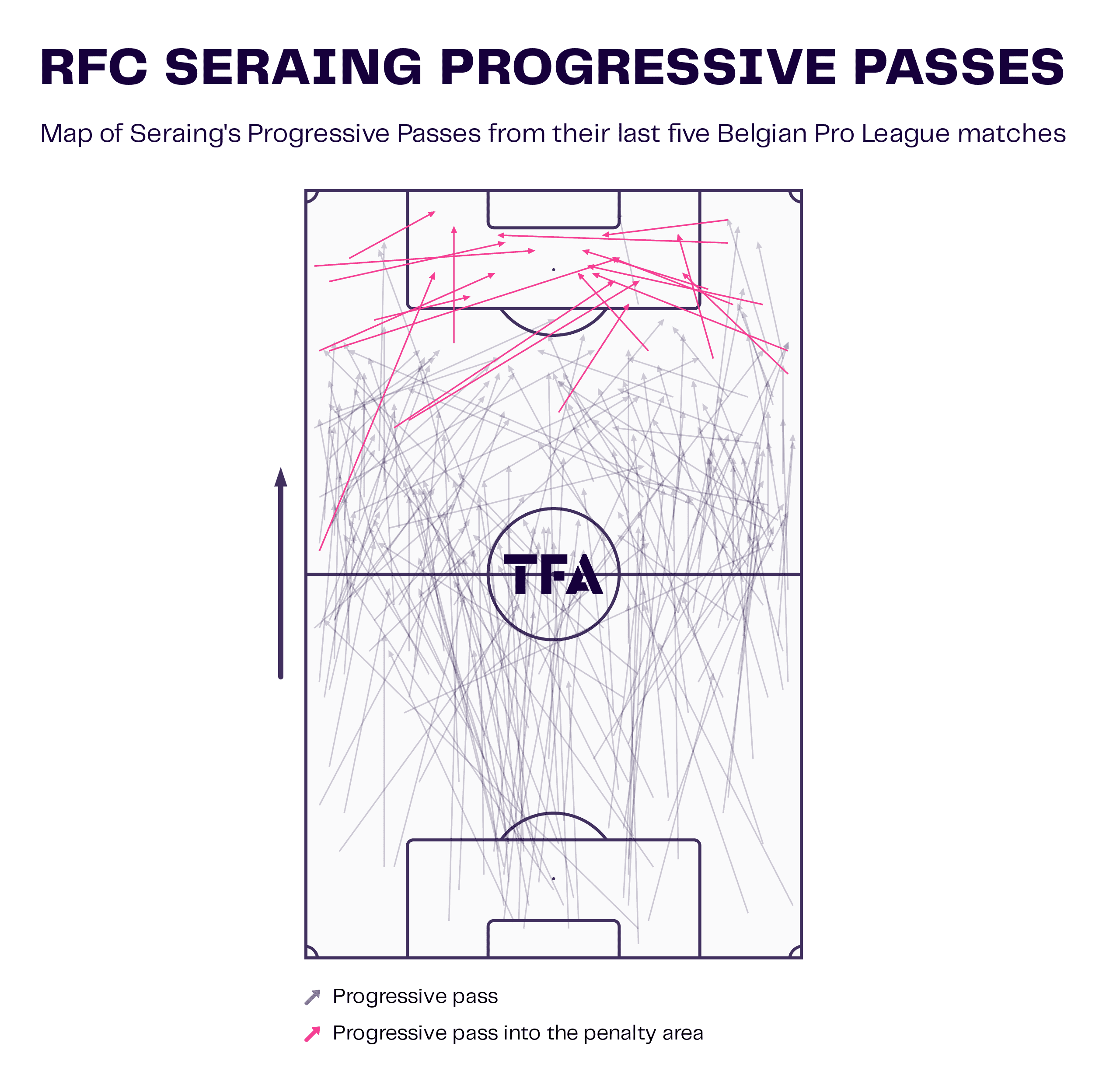
The data viz graphic above shows a recent sample size of the struggles that Seraing have had playing the ball vertically and progressing into the final third. Firstly, the majority of the progressive passes from the Belgian side have been long balls played from either the goalkeeper or from inside their defensive third, with usually nothing resulting from it. The graphic gets even more barren when we look at the final third for Seraing, with them not playing many progressive passes into the penalty area in their previous five matches. This lack of chance creation and inability to progress the ball vertically go hand-in-hand, with this graphic able to reinforce that point.
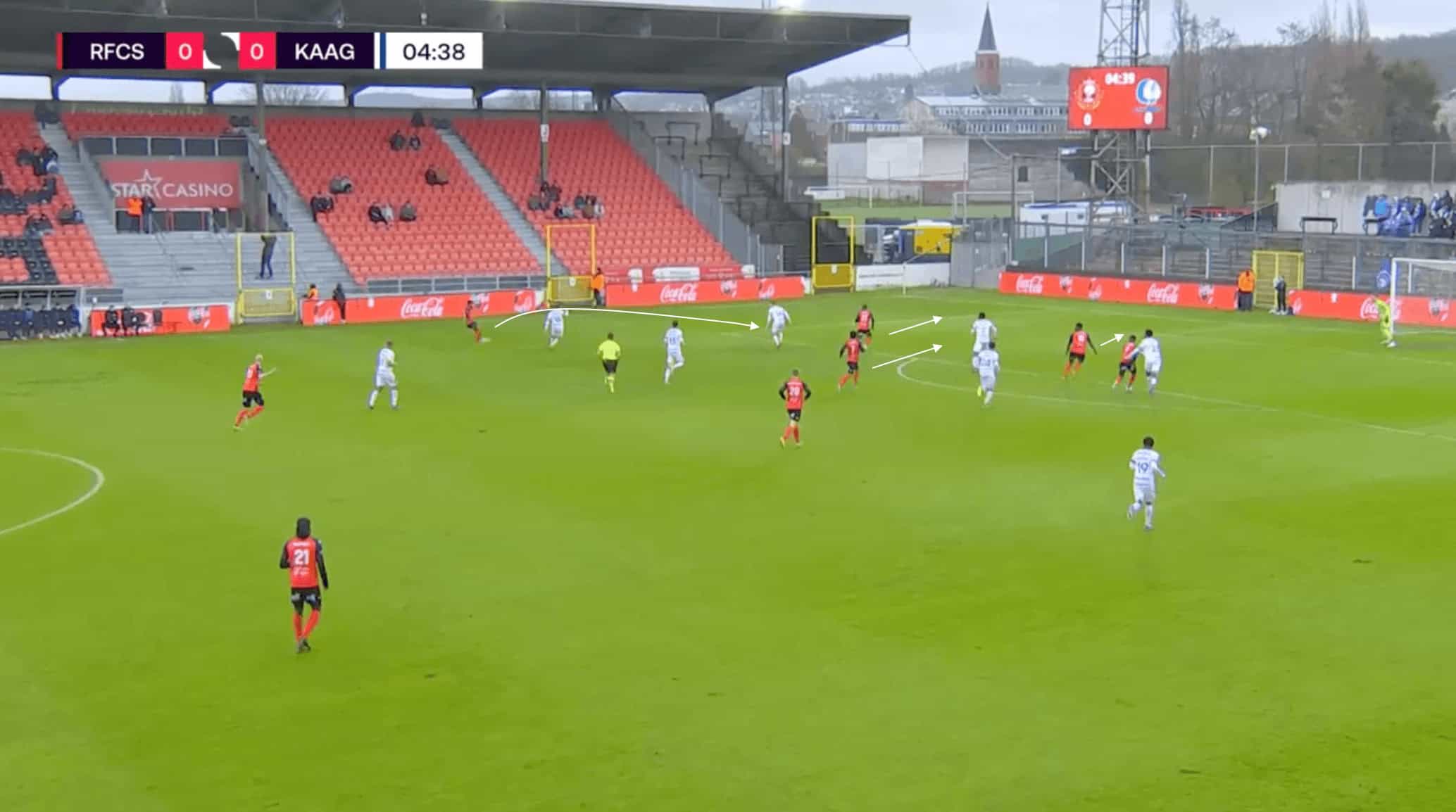
The image above is able to illustrate this lack of chance creation and ball progression into the penalty area from Seraing this season. A lot of this results from poor pass selection or attackers not making the correct runs to find the pockets of space in these advanced attacking positions. In the phase of play above from Seraing’s recent match against Gent, the Liège side actually are numbers up centrally on the edge of the penalty area, with them having a spare attacker against Gent’s three defenders.
The player in possession out wide spots the runs made by the attackers beyond the Gent defence, with him always looking to play the ball into this space. However, the quality of the pass is poor, with it not able to get past the Gent defence and into the space. Due to the poor quality of the ball, a potential chance creation opportunity goes begging, with Seraing forced to defend in a transitional moment due to the numbers they sent forward in this attacking phase. This has been a trend for Seraing from an attacking perspective this season, with the lack of quality in the final pass being detrimental to their chance creation this season.
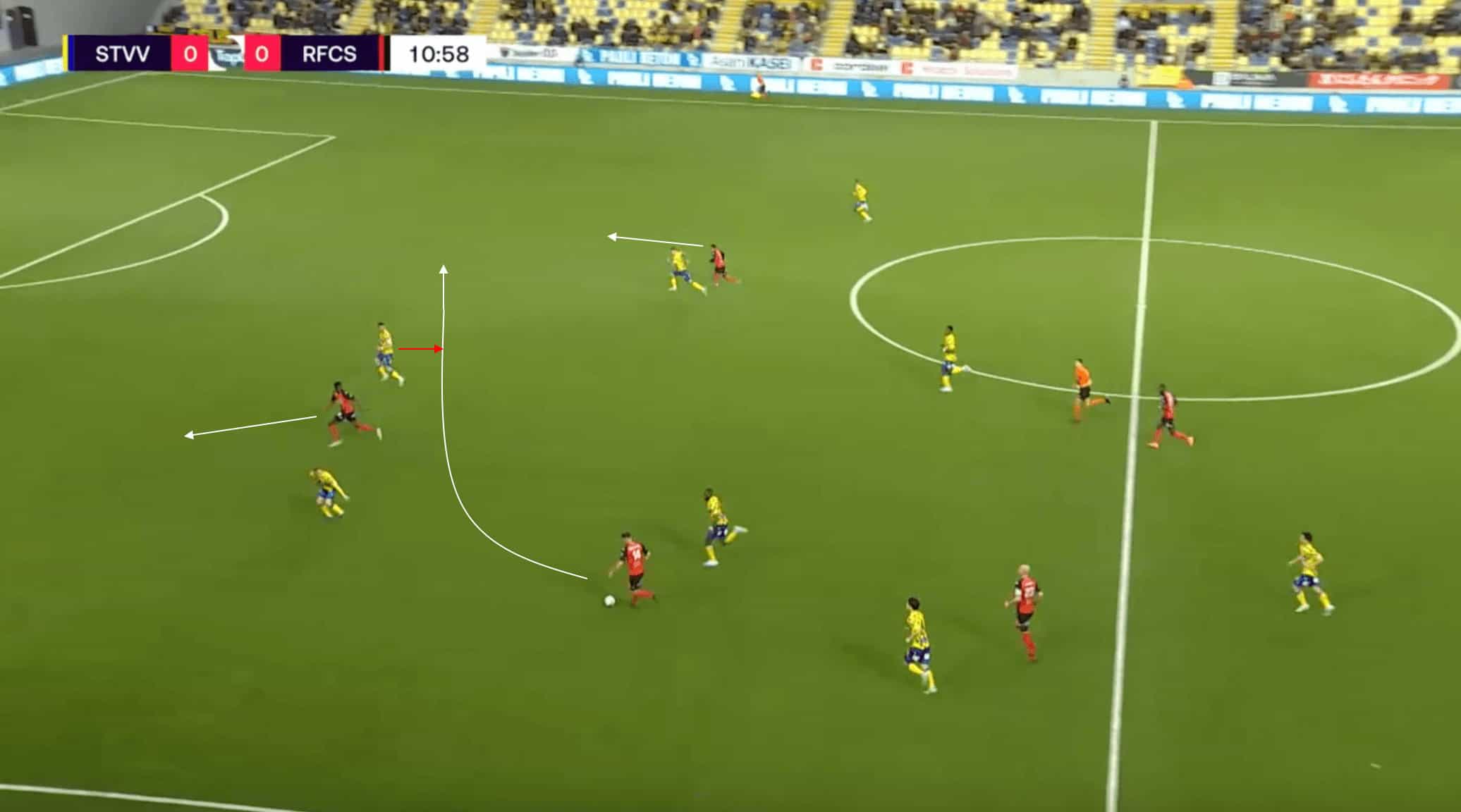
The image above again illustrates the lack of players in attacking positions as well as poor pass selection from a Seraing attacking move. In the phase of play above against Sint-Truiden, Seraing are in a transitional attacking move after winning back possession in their defensive third. Beyond the ball, there are only two attacking options for the Seraing wingback to play the ball too, with him deciding to attempt a switch of play ball into the path of the runner on the far side. This ends up being the wrong option as the ball is not hit well enough, with the Sint-Truiden centre-back able to step into the path of the pass and intercept it.
The interesting thing to note however is the run of Seraing top scorer Marius Mouandilmadji. The Chad international makes a great outward run into the space behind the fullback, becoming a dangerous option to be played behind the Sint-Truiden defence. However, the Seraing player in possession takes too long to notice this option, with Mouandilmadji running offside and not receiving possession. This means the only option is the switch of play ball, which allows the defender to easily read the pass.
This lack of attacking options as well as poor pass selection at frequent times has not allowed Seraing to progress the ball vertically into the final third often, which supports the statistics of Seraing being the worst attacking side in the league this season.
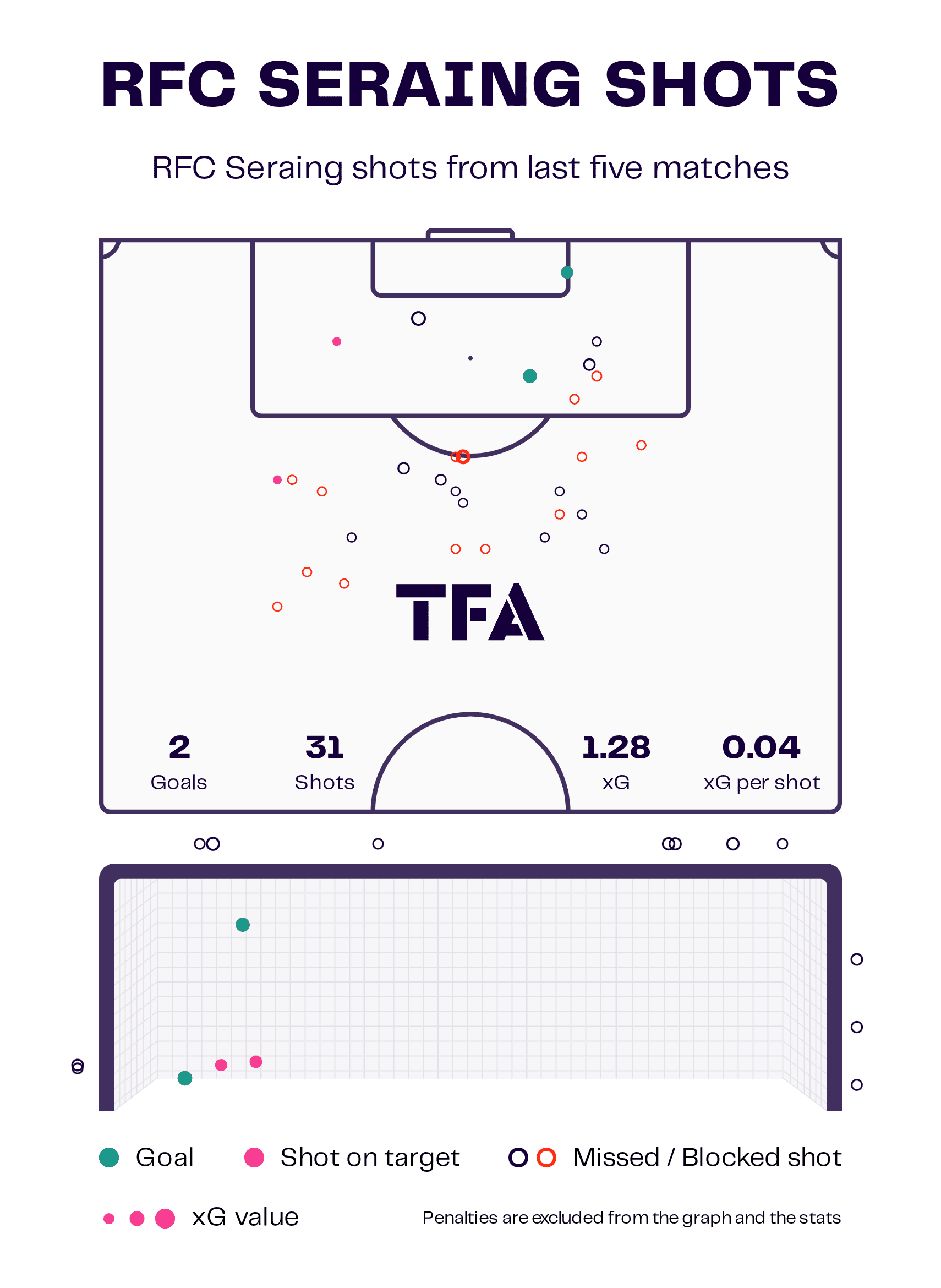
Another thing to look at that correlates well with the lack of ball progression and numbers forward is the lack of shots in favourable positions that Seraing are able to have. The data viz graphic above shows the number of goals, shots and xG from Seraing’s last five matches in the Belgian Pro League, as well as showing where in the attacking third their shots have originated from. Firstly, Legros’ side have only managed 1.28 xG from 31 shots in their last five matches, as well as only 2 goals. The main point however is that the vast majority of their shots have occurred well outside the penalty area, which goes back to their inability to progress the ball vertically into these areas.
From an attacking perspective, it is easy to see why Seraing have struggled so much this season. The inability to progress the ball into the penalty box and the areas around it on a consistent basis has limited their chance creation. This has then resulted in whatever shots they are taking being from well outside the goal-scoring range, as the graphic above illustrates.
All these factors combined highlight why the side from Liège rank last in essentially all the key attacking statistics in the league, with this lack of chance creation being one factor resulting in their imminent relegation from the top tier of Belgian football.
Poor at second phase defending: both set pieces and open play
From a defensive standpoint, while Seraing have not conceded the most goals this season in the Belgian Pro League, they are poor at second-phase defending in both set pieces and from open play.
Of the 63 total goals they have conceded this season, 13 have been from set pieces, one of the highest totals in the league. However, to make this section more specific, we have decided to look at the second phase defending that Seraing have struggled with for the majority of this season.
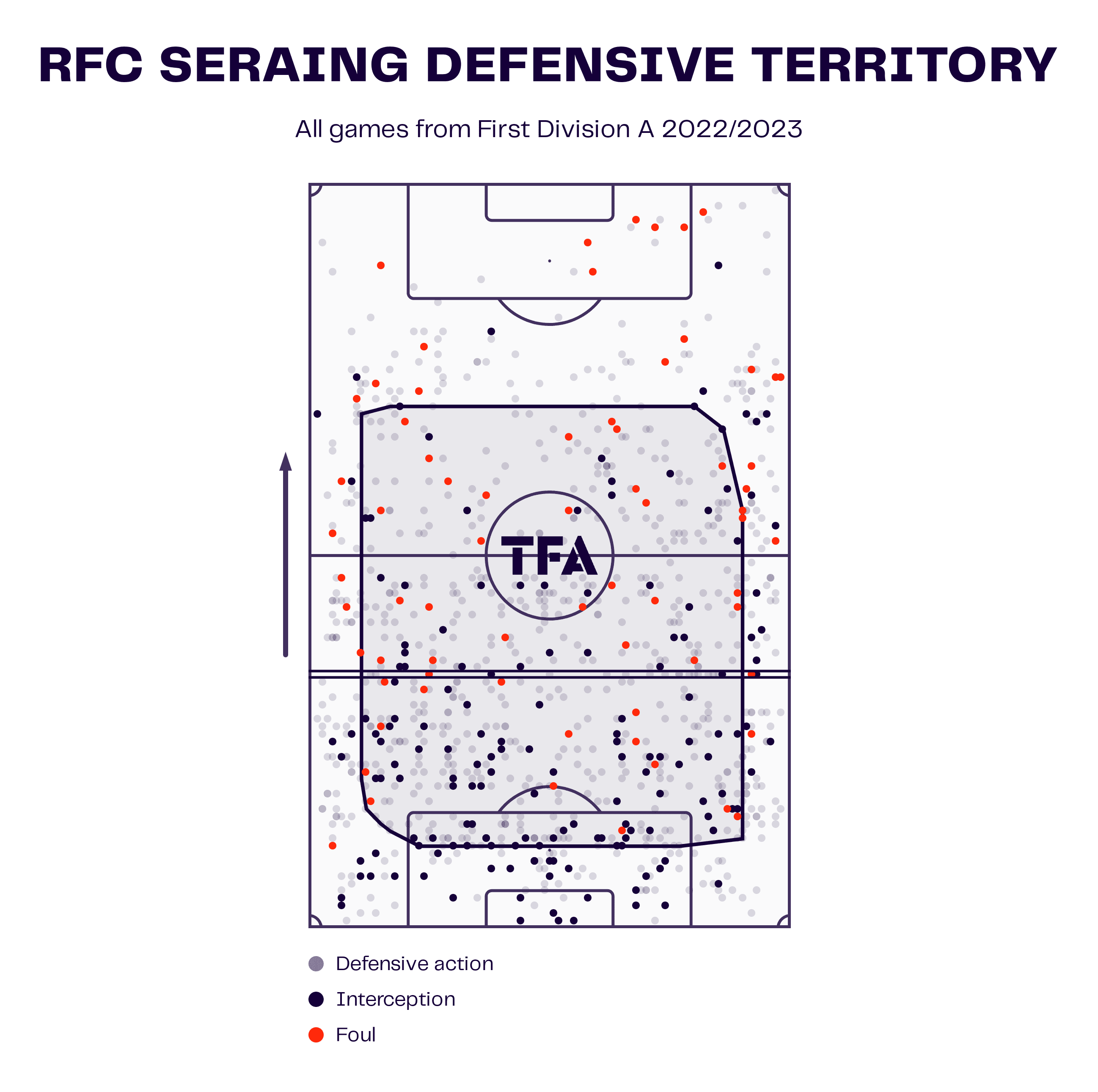
The data viz graphic above shows the average defensive territory of Seraing from this season, and we can see that they defend very deep, not putting much pressure on the opposition when they are in possession. With the defensive line constantly defending so deep, winning second balls in order to clear possession is key to giving the defensive line a break and not being under constant pressure. This is something that the Belgian side has not done well this season, and it has played a part in their impending relegation.
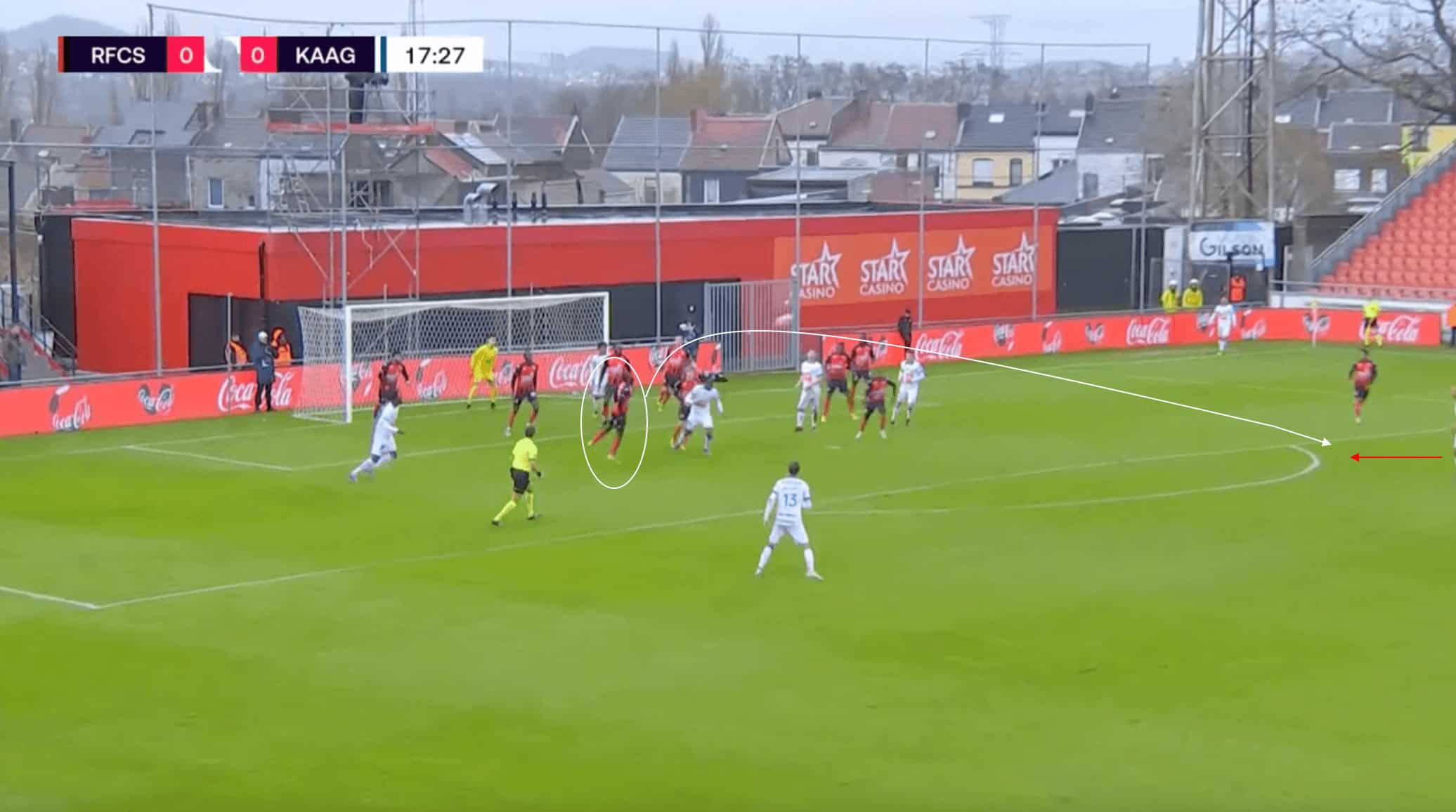
The image above shows an example of the struggles that Seraing have had when it comes to second-ball defending and not getting enough distance on their clearances. In the phase of play above, Gent’s corner is initially won by the Seraing defender, who is able to get his head on the ball. However, his clearance does not go nearly far enough, with the ball only being cleared to the edge of the penalty box. This allows the on-rushing Gent midfielder to reach the second ball first, with the intention of getting a shot off quickly.
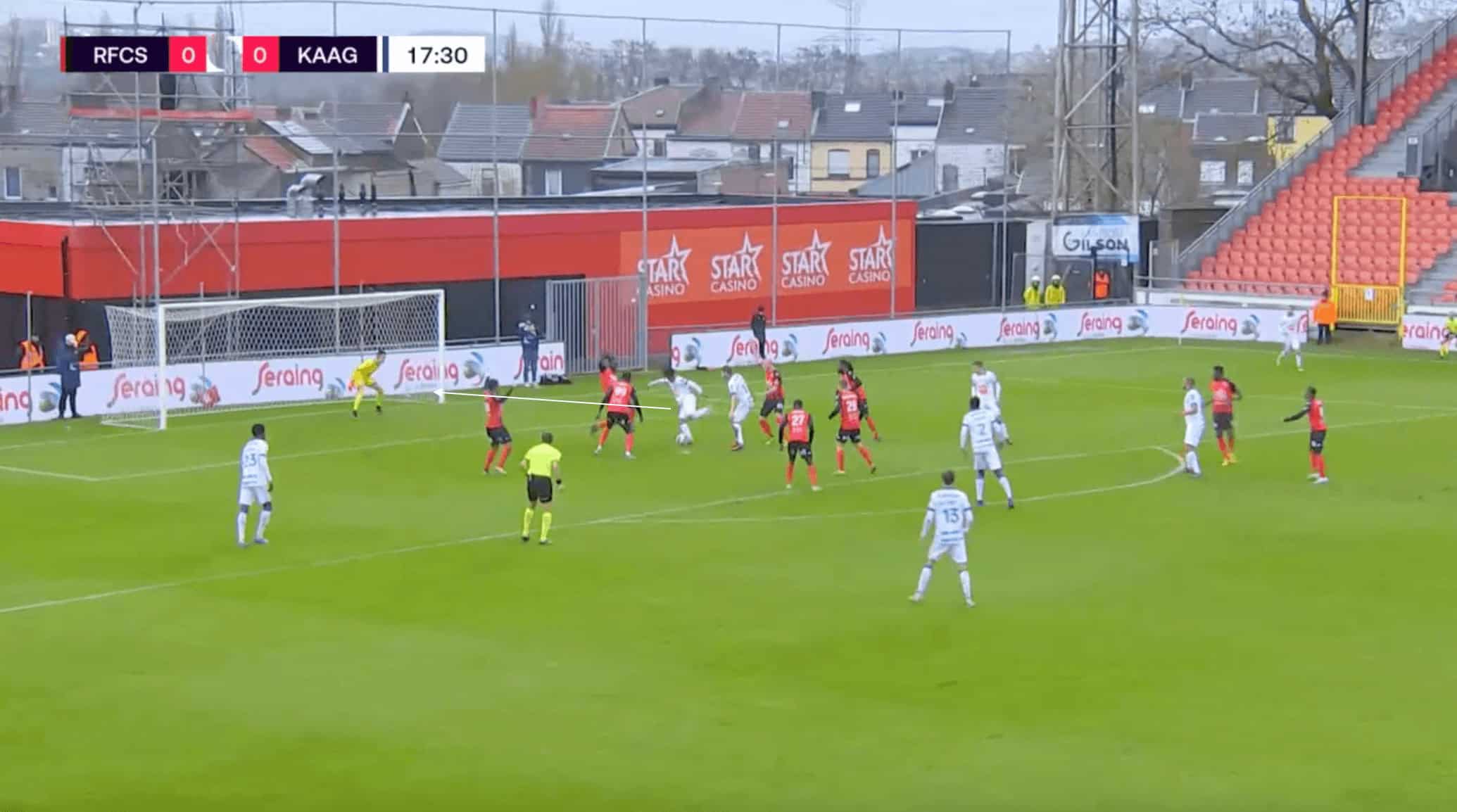
This next image shows the second ball phase once the Gent midfielder reaches the ball. As the ball drops, he is able to strike it first-time, with the ball finding its way to Leeds United, AC Milan, and Napoli transfer target Gift Orban. Even though Orban is surrounded by multiple Seraing defenders, none of them are able to react quickly enough, resulting in the Nigerian forward’s first-time shot finding the back of the net.
As a result of poor defending in the second phase of play, Seraing found themselves in another losing position that they ultimately could not overturn.
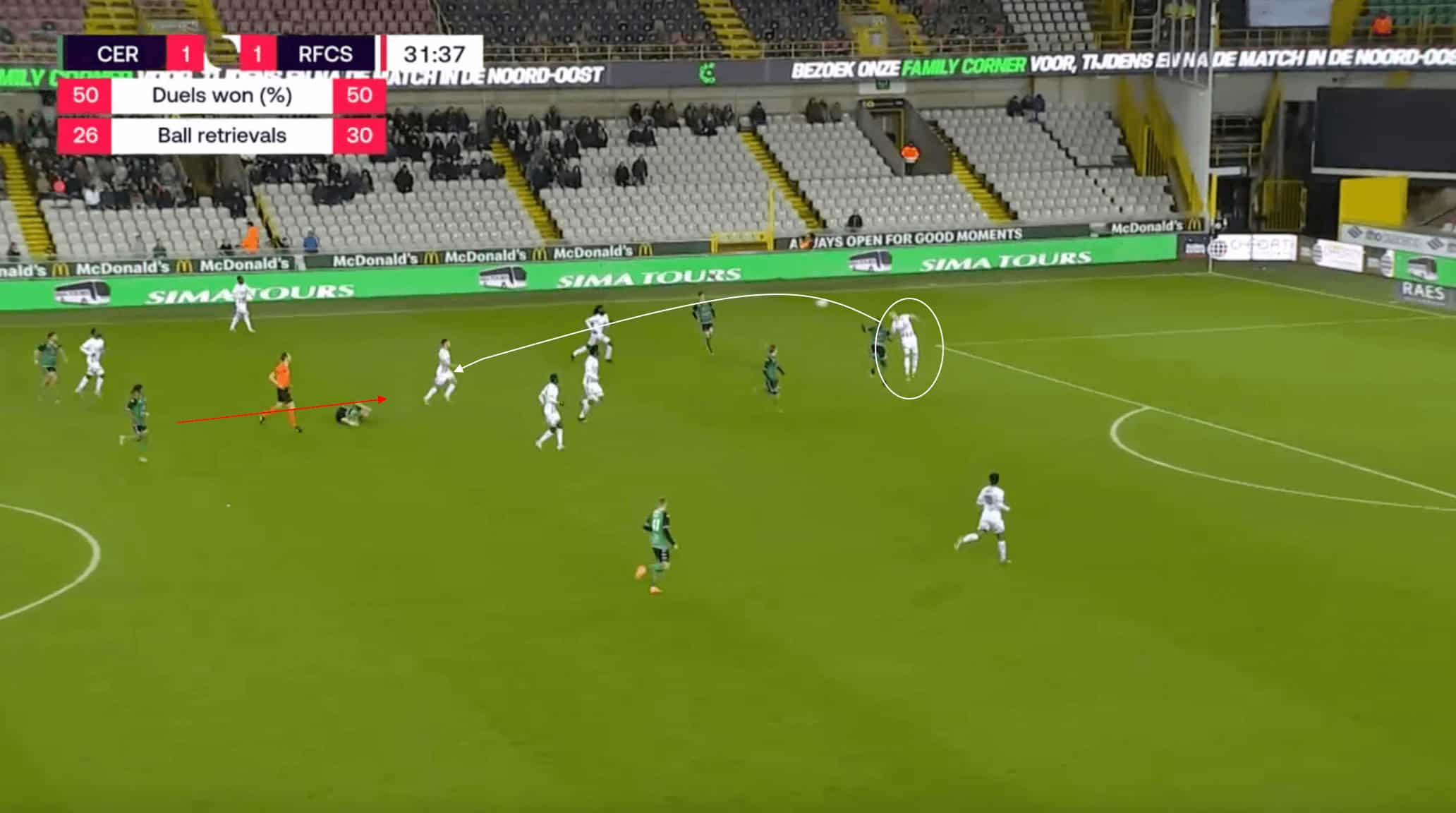
The image above shows another example of Seraing’s poor second-phase defending, this time from open play. The centre-back does well initially to get up to clear the first ball away from the Cercle Brugge attacker, with his clearance falling towards the Seraing player positioned just in front of the defence. However, Seraing are not able to keep the ball, with the onrushing Cercle Brugge midfielder able to gather possession of the second ball. This second phase ends up leading to a goal for Cercle, which is shown below, as a result of the Seraing defenders not getting set up quickly enough to defend against the second phase of play.
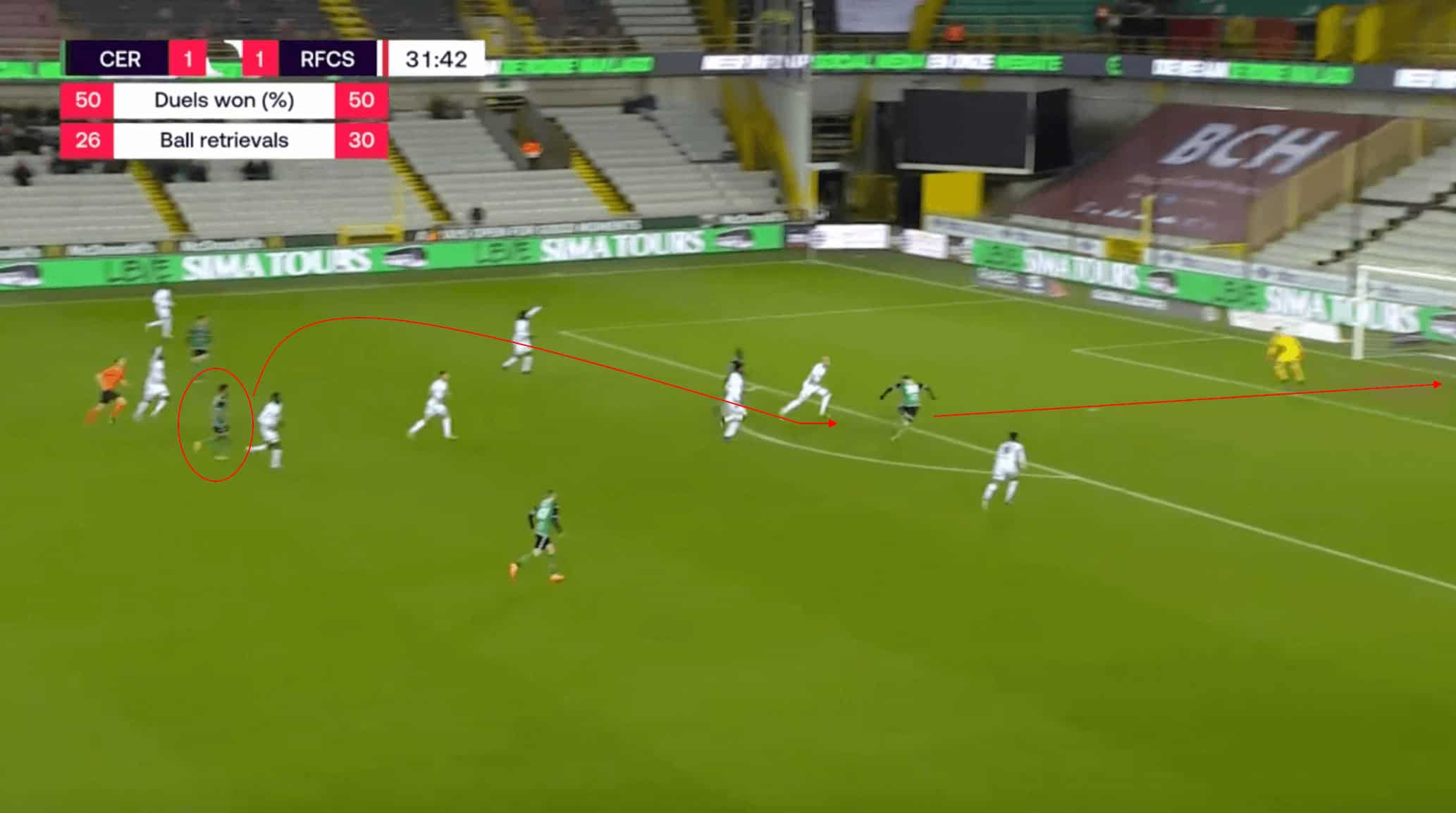
The above image shows the ensuing second phase that Seraing are not able to defend against. When the Cercle Brugge midfielder gathers possession, he is able to play a first-time ball over the top of the out-of-position Seraing defence. The ball is able to find its way to the most advanced attacking player, who receives possession and sends a shot past the goalkeeper with no pressure from the defenders. This inability to react quickly to the second phase of play has proved to be another reason why Seraing have not been able to maintain their top-flight status for next season.
This has been a troubling trend for Seraing this season, with the lapses in concentration when it comes to defending against the second phase of the attack not anywhere near good enough in key defensive moments, and being another reason the club are returning to the second division in Belgium next season.
Did the club get rid of José Jeunechamps too soon?
An interesting thing to potentially look at is whether the club were too quick to sack Jeunechamps after only his short spell in charge. For comparison, Jeunechamps was in charge for 14 matches with the Belgian side, managing three wins. His replacement, Jean-Sébastien Legros, has only two wins in his 17 matches in charge.
The style of play between the two is also slightly different. While Jeunechamps played a more attack-minded 3-4-3, Legros has been much more defensive, opting for a 5-3-2, with the defensive graphic from earlier showing just how deep he likes his defensive line to sit.
Now it’s hard to say whether or not the club were too quick to get rid of Jeunechamps, but they are worse off without him than they were with him. The club did not win a single game at home with the Belgian in charge, but they did have some impressive performances. Jeunechamps potentially should have been given more time with the Liège based side. However, the board at Seraing felt that there was a need for change.
To summarise, Seraing were the favourite from many to be one of the sides to go down this season, with their overall lack of quality compared to sides around them, and their partnership with FC Metz not being as viable to bring in loan talent with the club being relegated from Ligue 1 at the end of last season.
What can they do to improve next season?
With their relegation back to the Challenger Pro League confirmed, now the focus shifts to what the club could do to bounce straight back up next season. First and foremost, finding a new permanent manager should be priority number one for Seraing, with it looking unlikely that Legros will remain in charge come next season. The second thing would be to improve the quality of the squad. If Metz are to get promoted back to Ligue 1 next season, then there is the possibility of Seraing again being able to get more players on loan due to the two club’s partnership.
There are also some key members of the squad who are ageing, so being able to replace them with the correct profile of player would definitely help.
Also, Seraing should do everything they can to try and hold onto their young core, with Chad international striker Marius Mouandilmadji key among them. There will likely be squad turnover, but being able to replace whoever leaves will play a huge part in determining whether or not Seraing have the capacity to bounce straight back up.
Conclusion
As this tactical analysis piece has shown, Seraing have struggled all season, whether it was under the tactics and leadership of José Jeunechamps or currently Jean-Sébastien Legros. With the club now returning to the second division of Belgian football next season, all eyes will be on whether or not they have the capability to right the ship and come straight back up next season.





Comments